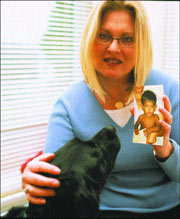On Aug. 12, a little-known drug company called Women’s Capital Corp. (WCC) will launch a 10-week local ad campaign for something called Plan B. If you’ve never heard of it, you’re not alone, but for many women, this lack of awareness could be tragic. Plan B is a “morning-after” pill that, when taken within 72 hours of unprotected sex, can prevent unwanted pregnancy. Drugs like Plan B could help at least 1.5 million women—the number of women in America who get pregnant due to contraceptive failure—each year.
Though emergency contraception (EC) has been around in various forms for nearly 30 years (see “A Short History of Emergency Contraception”), the first efforts to promote it began only five years ago. Today, despite the growing list of EC remedies and publicity efforts, public awareness has remained appallingly low.
“What’s unsettling about this is that these drugs can have a huge public health impact,” says Jane Hutchings, senior program officer at Program for Appropriate Technology in Health (PATH), the Seattle organization that coordinated early efforts to bring EC to the state.
Paulette Walker-Row, director of pharmaceutical care at the Washington State Pharmacy Association (WSPA), says that not only do women not know about the drugs, but even if they do, they don’t always know that the drugs are available in pharmacies and through clinics that keep longer hours than a doctor’s office. Among the first 1,200 women to request the drugs in Washington state, she says, between 50 percent and 60 percent sought the drug after 6 p.m. on a weekday or over a weekend.
Gynetics, the Lawrenceville, N.J.- based company that sells an EC drug called Preven, estimates that more than 50,000 unintended pregnancies begin each week in the U.S. While women, even minors, have access to the drug in other countries such as England (where grocery and drug chain Tesco dispenses it for free), Denmark, Israel, South Africa, and Canada, it’s much harder to find in the U.S.
So why isn’t the drug better known or utilized? Surprisingly, anti-abortion foes aren’t the main reason. The truth has more to do with the mechanics of the pharmaceutical industry and drug advertising.
Sharon Camp, CEO of WCC, is aware that launching a print and radio ad campaign in sleepy Seattle won’t make Plan B a household name like Pfizer’s Viagra, Eli Lilly’s Prozac, or Schering-Plough’s Claritin—at least not with her start-up company’s fledgling marketing budget. Yet, if there is one state where Plan B, or any other emergency contraceptive, ought to take off, it’s Washington. That’s because the state’s pharmacy, physician, insurance, and government agencies have all implemented policies to make EC access easy.
“One of the things that the ad campaign will test is whether we’ve saturated this market or we’re picking the low-hanging fruit in terms of audience,” Camp says. “The major barrier to increasing sales of Plan B is that women don’t know they have the option.” Right now, Washington state accounts for 14 percent of the Washington D.C.-based company’s Plan B revenues.
Despite this state’s pro-EC measures, Camp says that sales haven’t picked up that much since the drug first became available three years ago. “Awareness is not growing,” she says. Walker-Row says that state pharmacies prescribe EC a combined total of 1,200 times per month—a figure that has remained flat over the past few years.
Washington made its first strides with EC in 1997, when Seattle nonprofit PATH led a domestic pilot of an EC program it had created for family planning in developing countries. Leveraging a 1979 state law that lets pharmacists prescribe specific drug types (such as flu shots) directly to customers after securing a doctor’s consent and approval through a “collaborative drug therapy agreement,” PATH has turned pharmacist prescription of EC into standard practice—a first in the U.S. Following Washington’s lead, California began offering residents pharmacist prescription in January, and states including Alaska, Ohio, Montana, and New York are evaluating doing so.
The number of pharmacies that offer EC through collaborative agreements in Washington has grown from 40 in 1998 to over 250, according to PATH’s Hutchings. While that’s progress, this represents only about 20 percent of the state’s 1,242 pharmacies, as counted by the WSPA. “It’s still vastly underused,” says Hutchings. “I think the key thing is once it becomes institutionalized—taught at the university pharmacy schools and associations—it’s going to become more routine.” Pharmacy schools of the University of Washington and Washington State University have added discussion of the drugs to the curriculum, she says.
Washington was also one of the first states to require all state-regulated insurance plans to cover EC, through a ruling from the state insurance commissioner’s office that became law in January. Forty percent of the Washington population is covered by state-regulated insurance, according to Robert Harkins, executive director of Planned Parenthood Affiliates of Washington. He adds that 50 percent of pregnancies in Washington state are unintended, though the number that are “unwanted” within that statistic is harder to quantify. But both Harkins and WSPA’s Walker-Row point out that since 40 percent of all unwanted pregnancies result in live births, and half of those births are state-subsidized at $3,600 per birth, offering a $35 drug is clearly logical from an economic perspective.
If Washington is a “high awareness” state, EC advocates say, awareness elsewhere in the U.S. isn’t great. In March, Maryland Sen. Connie Morella launched a national bill recommending that all emergency rooms discuss and offer EC to victims of sexual assault. In Washington, a state bill passed in February requires that all hospitals with emergency services provide information on EC and access to the drug to victims of sexual assault. Yet Harkins says that in one study of emergency rooms, despite the new law, as many as 25 percent didn’t offer this. “Planned Parenthood knows of an example of a homeless woman in Tacoma who was brutally raped,” he says. “She was in a coma for several days and was not given EC or informed [when conscious] of her options to get it. We hope this is the first step in an examination of this process.”
Sen. Patty Murray (D-Wash) co- introduced a March 2002 bill with Sen. Louise Slaughter (D-N.Y.) called the Emergency Contraception Education Act. Citing the statistic that fewer than 12 percent of American women know of FDA-approved EC methods, and that consumers as well as sexual assault victims in emergency rooms aren’t being informed of the option, the bill recommends spending $10 million on a five-year education program that would kick off in 2003.
Aside from the bill, still circulating in Congressional committees, several grassroots campaigns with informational Web sites and toll-free numbers have helped spread the word about EC. The drugs have been pitched on campuses, and local student activists like Brittany Goodnight and Jenna Huntsberger, juniors at the University of Washington, have set up tables, distributed flyers, and tried to educate classmates about EC resources. “We’ve done work to make EC an important campus issue,” said Huntsberger last spring, around the time of the campus Reproductive Freedom Fair.
On campus, female students can get EC for $12 to $13 from Hall Health, the student health facility, but the organization’s hours aren’t as extensive as the two activists would like—and student awareness isn’t what they think it could be. Despite dorm-monitor training sessions in 2000 and 2001, Goodnight says her efforts and Huntsberger’s “weren’t as successful as we’d hoped.”
From a business perspective, part of the problem with emergency contraception is that it’s not a drug designed for frequent use, nor is it a drug launched by a major drug company with a megabucks marketing budget. (Pfizer, maker of Viagra, was the fifth largest U.S. advertiser last year, spending $2 billion to market its drugs.) Aside from Plan B, there is only one other “branded” emergency contraceptive—Preven, a drug kit that lets a woman take a one-time combination of existing oral contraceptive pills for EC use. Lack of backing by a behemoth pharmaceutical company means that costly advertising to boost consumer awareness is impossible.
But if a major marketer doesn’t stand to make tons of money from a new drug, despite the market for it, then whose responsibility is it to tell women about EC’s availability? “I think it’s all of our responsibilities,” says Sharon McAllister, family planning and reproductive health section manager at the state Department of Health. “It’s an interesting question during this time of budget shortfalls.” Some proponents say doctors should educate women about availability, but WCC’s Camp says “even at the annual visit, there’s not a lot of time to discuss it. Some doctors may also think it sends a mixed message, that it gives women permission to screw up their current birth control method.”
Sen. Murray, at a press conference following an announcement about the proposed Emergency Contraception Education Act, also emphasized that the medical community often neglects to educate patients. “We know that counseling in many emergency rooms—about safe and effective emergency contraceptives—is simply being ignored,” she said. “Providing emergency contraceptives is still not standard protocol in many instances. By educating women, they will not be at the mercy of overworked health care providers.”
Some doctors also invoke the state constitution’s “conscience clause.” This clause allows a health professional to essentially decline a particular medical service (such as abortion) on moral or religious grounds. Washington is not the only state where a conscience clause forms the rationale for a doctor or hospital to decline offering a particular service.
And it’s true that at pharmacies, where collaborative drug agreements are voluntary, the prescriptions are mostly available in urban areas. Some major chain stores with pharmacy departments, such as Wal-Mart, have made corporate decisions against offering the drug, period.
Even pharmacy chains that endorse, or allow, prescription of the drug don’t necessarily offer it uniformly. Because pharmacists who choose to enter into a collaborative drug therapy agreement to prescribe the drug do so on an individual basis, a pharmacy employing multiple pharmacists might have only one staff member with prescription credentials.
That became clear for Natalie Reber, chair of Pro Choice Washington. In June 2001, Reber says, when she discovered she needed morning-after pills, she knew she could get them directly from a pharmacist but called her doctor because she specifically wanted Plan B, which she got from a Bartell Drugs downtown. Told that other Bartells stock emergency contraceptives, she decided to check several stores. Pharmacists she talked to at seven Bartells didn’t prescribe Plan B last summer—although Bartell, along with Fred Meyer, is known to stock the drug.
“I think when the pharmacies began dispensing it, they were upset about reaction from the anti-abortion community.” Reber says. Confusion between emergency contraception and RU-486, the French “abortion pill,” has also created challenges for purveyors of EC. Technicalities over when and how the drugs prevent fertilization of a woman’s egg—vs. preventing implantation of a fertilized egg—can edge the debate over emergency contraception into a discussion about the technical definitions of abortion. No EC marketer or supporter considers the way these pills work a form of abortion. Packaging mentions the drugs will not terminate existing pregnancies and should not be used more than 72 hours after sex.
Still, when Reber got her prescription from Bartell last year, the store gave her a handout about the drug’s ingredients and side effects from Data Bank, a drug database common in many U.S. pharmacies. The handout included a sentence that read: “You should be aware that some consider this a form of abortion since a fertilized egg will not attach to the uterus wall.”
While the since-updated Data Bank doesn’t include such language, the 2001 message bothered Reber. “For a 16-year-old girl who is newly sexually active, this could be really confusing,” she says. Beverly Schaefer, a pharmacist for 32 years at Katterman’s on Sand Point Way and one of the first local pharmacists to get involved in EC dispensation, agrees. “This makes me crazy,” she says. “That to me is such a strong wording . . . this is what regular contraception does.”
Language aside, Schaefer says that offering EC has been an important, if rarely used, service at her pharmacy—and one that is becoming, albeit slowly, more mainstream. While Katterman’s is located in a family-oriented community, she said she signed up to offer it early on because she wants to be “progressive.” She lists emergency contraception on a list of specialty services (including immunizations and services geared to the elderly, like canes and compression hose for swollen legs) and sells Plan B for $35, “the price for a month’s worth of birth control pills,” she says.
Schaefer has isolated a private area— essentially a desk surrounded by anatomy posters—where she can counsel those seeking EC. As part of an initial wave of 115 pharmacies in-state that made EC available in 1998, she was interviewed in a page-one New York Times story she’s mounted on the wall. Since she began offering EC, she’s gotten a few requests a month—mostly from women in committed relationships, occasionally from a distraught mother who already has children and wasn’t planning more.
She has given it to teens. “Do we want to go there?” she asks, before disclosing that the youngest EC recipient was a teenager who came in the day after her 15th birthday. As informed consumers like Reber jump through the appropriate hoops to access the drug, and firms like Women’s Capital Corp. launch what modest marketing initiatives they can afford, it’s still unclear if the message about EC will come across any louder or clearer in the near future. Sen. Murray’s education bill is in committee limbo, while both Preven and Plan B remain the products of small, private companies with limited marketing muscle.
And though right-wing and religious groups don’t aggressively challenge EC, those that oppose contraception in any form aren’t exactly routing for it. The Catholic Church, for instance, voiced its views when the state moved to provide EC access in emergency rooms but did not ultimately challenge the bill. “They stood aside, I think, because they knew it would eventually pass,” says Planned Parenthood’s Harkins.
Furthermore, the Bush administration’s conservative leanings on family planning don’t promise positive news for the passage of EC bills and funding. On July 22, the State Department redirected $34 million earmarked for the UN Family Planning fund to the U.S.-run Agency for International Development, a move made in part to better monitor women’s health choices abroad. Add this to the administration’s earlier efforts to limit access to abortion for enlisted women abroad, its attempt to cut insurance coverage of contraception for federal employees (an effort that was repealed), and an increase in funding for abstinence-related sex education, and the climate is not rosy.
Still, for pharmacists like Schaefer, who has seen the response to the drug’s availability shift slightly over the years, there’s a lot of hope in the morning-after pill. “There’s less of a lack of awareness today than there was four years ago, but there’s still a lack of knowledge about where to get it,” says Arlene Fairfield, a senior vice president at DDB Bass & Howes, the Seattle agency responsible for creating the Plan B campaign that launches this week.
“I had some concerns about my family clients worrying about this,” Schaefer says. Initially, women who came in were agitated, she says, but now they’re calmer and know what to ask. Additionally, many adults—mostly women—often take Schaefer aside and speak to her in hushed tones about how offering EC is a good thing. “People come up to me and say, ‘Listen, if someone without any money comes in and needs this, just charge it to my account.'”
A Short History of Emergency Contraception
1960s: High dosages of estrogen-based contraceptives were first used as emergency contraception.
1970s: A Canadian doctor named Albert Yuzpe became the first to experiment with combining different groups of pills from traditional oral contraceptives to create EC. Women were also advised to insert copper IUDs postcoitally to prevent unintended pregnancy.
1970s to mid-1990s: Doctors and others developed 13 different “Yuzpe method” variations on blending and applying oral contraceptives in different combinations to serve as EC.
1996: Two 30-second ads on MTV created spikes in the number of phone calls to the then-new 1-888-NOT-2-LATE hotline managed by Princeton. On a typical day, the hotline received about 133 calls, but following the ads, the hotline got over 4,000 calls in one day.
1997: The FDA approved several Yuzpe-style combinations of oral contraceptives. Washington’s PATH began its pilot project, allowing pharmacists to prescribe EC.
1998: The FDA approves a privately-branded EC method called Preven.
1999: Women’s Capital Corp. launches Plan B, an EC method that uses different active ingredients (levongestrel, instead of estrogen and progestin) and claims fewer side effects than Yuzpe-style EC drugs.
2002: California becomes the second state to offer EC direct from pharmacies in January. Sen. Patty Murray proposes a $10 million education bill to promote awareness about EC in March. 







